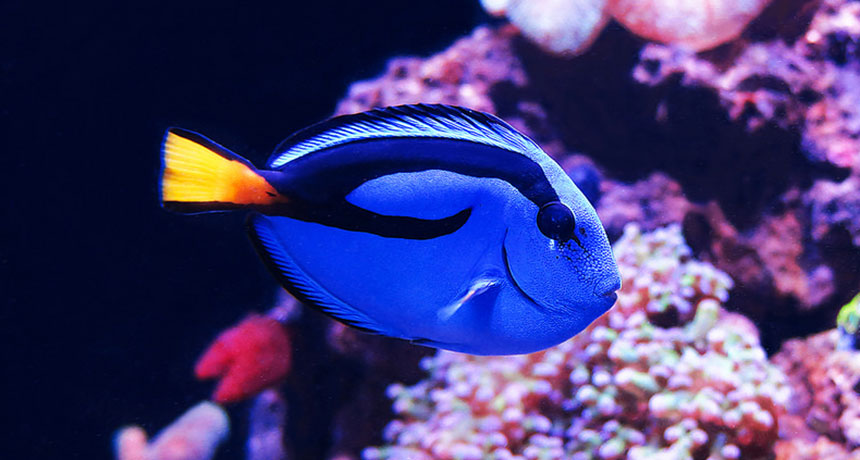That ‘Dory’ for sale may have been poisoned with cyanide

Blue tang fish can’t be bred in captivity, so every “Dory” sold in shops was caught from the wild. And there’s a high likelihood the fish was caught with cyanide, new research shows.
Stéphane Duquesne/Flickr (CC-BY-NC 2.0)
- More than 2 years ago
In the years after the animated movie Finding Nemo was released by Pixar in 2003, sales of clownfish spiked as fans, little and big, rushed to buy their own “Nemo.” So many Nemos were purchased that the sales actually depleted some wild stocks of the fish. Pressure on those wild populations has since dropped, thanks to efforts to increase captive clownfish breeding. But now there are worries that Nemo’s sequel, Finding Dory, may have a similar effect on Dory’s species, the blue tang — and an even bigger impact on the coral ecosystems in which these fish are found.
Despite concerted efforts, scientists have been unable to convince blue tangs to breed in captivity. That means that every blue tang, every Dory, sold has to be captured from the wild. And a surprisingly large number of those fish are captured with cyanide, new research shows.
Most of the 11 million fish sold in the U.S. aquarium trade come from coral reefs in the Indo-Pacific. In some places, like Hawaii and Australia, there are decent rules and enough enforcement of them that fish can be collected without too much harm to ecosystems. But in others, there aren’t enough laws or enforcers to prevent disturbing, destructive practices, such as fishing with explosives or cyanide.
For the aquarium trade, cyanide fishing is “cheap and easy to do,” says Craig Downs, executive director of the Haereticus Environmental Laboratory in Clifford, Va. A diver adds a pellet of cyanide to a bottle and squirts a bit on a target fish. Or they may use larger quantities pumped down from their boat. The poison quickly stuns the fish, which can then be captured and later sold.
But cyanide is deadly. Coral exposed to cyanide bleaches and dies. Other fish and organisms left behind can die. Even the fish that enter the aquarium trade may die within a few weeks or months of being caught. “If you survive [exposure], you’re messed up for the rest of your life,” Downs says. And while there are laws that should prevent divers from employing this fishing method — and from wholesalers in the United States from being able to purchase fish caught this way — “this practice happens all through the Indo-Pacific,” says Downs. As many as 30 million fish may be caught this way every year, and 90 percent of those may die.
There is no way for someone purchasing a fish in a pet store to tell if the animal had been exposed to cyanide. “You have to be a fish pathologist” to see the signs, Downs says. But after a fish, human or other organism is exposed to the toxin, it will excrete a cyanide metabolite, thiocyanate, in its urine. And this can be detected in the water in which a captive fish is living.
Recently, Downs and Rene Umberger, director of the nonprofit organization For the Fishes, wanted to get an idea of how many fish sold in pet stores were caught with cyanide. They purchased 89 fish from shops in California, Hawaii, Maryland, North Carolina and Virginia, collected water samples and sent them off to an independent laboratory. More than half came back positive for cyanide exposure, including many of the blue tangs. None of the fish from companies that breed fish in captivity came back positive, though. The results of this initial study will be presented later this month at the International Coral Reef Symposium in Hawaii.
A 2008 report from NOAA estimated that 90 percent of the aquarium fish imported into the United States were captured with cyanide or other illegal methods. And Downs suspects that cyanide use for the fish in his study may be higher than he and his colleague are now reporting. The fish only excrete detectable levels of thiocyanate for a short time after exposure. Plus, initial runs of a more sensitive method for detecting the chemical show that many of the negatives may really be positives for exposure, he says.
He is hoping that this method might be turned into an easy tool that can be used by consumers, citizen scientists and enforcement agencies to quickly detect fish that have been illegally caught with cyanide, which would hopefully drive down the trade.
This doesn’t mean that all saltwater fish are off limits for consumers, though. “If consumers really want to have coral reef fish, then going the cultured route is the way to go,” Downs says. There aren’t many of those fish — only 42 or so species among the more than 1,800 currently traded in the United States — but identifying them is easy. Umberger’s group has a free iOS app, Tank Watch, that lists them all. And even though the app doesn’t list every species that may be in a store, if a species isn’t on their good list, it can be assumed to be bad.
So go ahead and buy Nemo, if you must, but leave Dory and most of her fishy cousins where they belong — in the ocean.






